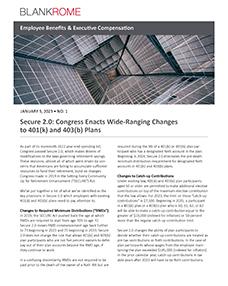Secure 2.0: Congress Enacts Wide-Ranging Changes to 401(k) and 403(b) Plans
As part of its mammoth 2022 year-end spending bill, Congress passed Secure 2.0, which makes dozens of modifications to the laws governing retirement savings. These revisions, almost all of which were driven by concerns that Americans are failing to accumulate sufficient resources to fund their retirement, build on changes Congress made in 2019 in the Setting Every Community Up for Retirement Enhancement (“SECURE”) Act.
We’ve put together a list of what we’ve identified as the key provisions in Secure 2.0 which employers with existing 401(k) and 403(b) plans need to pay attention to.
Changes to Required Minimum Distributions (“RMDs”)
In 2019, the SECURE Act pushed back the age at which RMDs are required to start from age 70½ to age 72. Secure 2.0 moves RMD commencement age back further to 73 beginning in 2023 and 75 beginning in 2033. Secure 2.0 does not change the rule that allows 401(k) and 403(b) plan participants who are not five percent owners to defer pay out of their plan accounts beyond the RMD age, if they continue to work.
In a confusing dissimilarity, RMDs are not required to be paid prior to the death of the owner of a Roth IRA but are required during the life of a 401(k) or 403(b) plan participant who has a designated Roth account in the plan. Beginning in 2024, Secure 2.0 eliminates the pre-death minimum distribution requirement for designated Roth accounts in 401(k) and 403(b) plans.
Changes to Catch-up Contributions
Under existing law, 401(k) and 403(b) plan participants aged 50 or older are permitted to make additional elective contributions on top of the maximum elective contribution that the law allows. For 2023, the limit on these “catch-up contributions” is $7,500. Beginning in 2025, a participant in a 401(k) plan or a 403(b) plan who is 60, 61, 62, or 63 will be able to make a catch-up contribution equal to the greater of $10,000 (indexed for inflation) or 50 percent more than the regular catch-up contribution limit.
Secure 2.0 changes the ability of plan participants to decide whether their catch-up contributions are treated as pre-tax contributions or Roth contributions. In the case of plan participants whose wages from the employer maintaining the plan exceeded $145,000 (indexed for inflation) in the prior calendar year, catch-up contributions in taxable years after 2023 will have to be Roth contributions.
Matching Contributions for Student Loan Payments
For years after 2023, employers will be permitted to make 401(k) and 403(b) plan matching contributions for their employees who make “qualified student loan payments.” This provision is an assist to employees whose student loan costs prevented them from making elective contributions to their employer’s retirement plan.
Employees Permitted to Elect to Have Employer Contributions made as Roth Contributions
Effective immediately, employers are permitted to allow their employees to elect whether employer matching contributions and nonelective contributions are pre-tax contributions or Roth contributions.
Emergency Savings Accounts
Beginning in 2024, Secure 2.0 permits employers to automatically require 401(k) and 403(b) plan participants who are not highly compensated employees (under the IRS definition) to make after-tax contributions into an emergency savings account under the plan, at up to three percent of compensation. If the plan provides for matching contributions, the employer will be required to match these contributions in the same manner as other employee contributions. There are limits on the maximum dollar amount of these contributions and special rules affording employees access to the amounts in the accounts and the manner in which the accounts may be invested.
Expanded Coverage of Part-Time Employees
The SECURE Act added a requirement that part-time employees who work at least 500 hours in three consecutive years and who are least 21 years old at the end of the third year must be permitted to make elective contributions to their employer’s 401(k) plan. Beginning in 2025, Secure 2.0 reduces the three years to two years.
Simplified Record-Keeping for Hardship Distributions
Effective immediately, employers will not be required to obtain documentation to support a request for a hardship withdrawal from a 401(k) plan and can rely upon the employee’s certification as to the need and amount required to satisfy the hardship.
Increase in Dollar Limit on Cash Outs
Effective in 2024, the maximum amount of a terminated 401(k) plan participant’s account that may be involuntarily cashed out by the plan has been increased from $5,000 to $7,000.
As one would expect, these changes come with a host of additional rules and requirements. If you would like further information about these changes or any of the other provisions of Secure 2.0, please contact Dan Morgan, Andy Rudolph, or another member of Blank Rome’s Employee Benefits & Executive Compensation group.


